Every season starts with expectations of what style of log home will come first. The first home this year that needed our restoration experience happened to be a 1980’s turned log style resort lodge. The charm was evident, as it was located on Rice Lake in Northern Wisconsin. Every place that Edmunds and Company sets out to restore has a story worth telling but let’s focus on the actual construction of this building and why we were hired.
Turned log style (where every log is exactly the same in diameter) is a style of construction that took off in the United States about 30 years ago. Over the years, different companies have manufactured kits and marketed package deals. Typically there is a raw processing plant that can manufacture uniform logs – one after the other – in an assembly style. These logs can be made into several sizes specific to a customer’s specifications. The notching can vary widely depending on preference and budget. For manufacturers – the style has proven to be a good use of non-uniform wood sources and this has reduced the cost of these log homes as well.
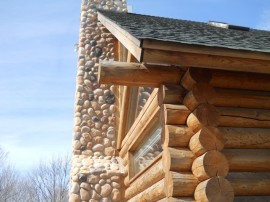
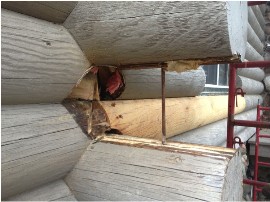

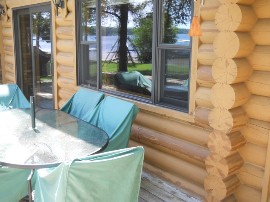
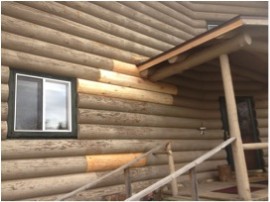
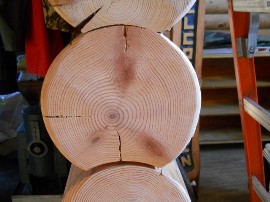
There are several factors that lead folks to the decision to build their log home or cabin in the “turned log style”. Cost is a big one. The cost savings mostly comes when it is time to construct the actual building on the site. The scribing and coping is ready to go and this is a large labor savings. Manufactures have been able to mechanize and more accurately bid the cost of constructing log homes, resulting in a lower costs for these log homeowners.
Regardless of the many benefits associated with the turned log building style, there are definitely some pitfalls. Because they have always been marketed as a low-cost way to own a log home, some of the design details that might have gone into a higher-end log home may have been passed over. Specifically – a good stain, large overhangs, roof flashing, deck attachment, and foundation details seem to be lacking in these homes.
A specific problem associated with these homes is upward facing checks on the surface of the logs. We sometimes see excessive checking because many times, a log goes through the mill and because of the way the tree grew — it is not centered. Some of the worst checking we have seen is on turned log homes. Up-facing checks in vulnerable places can cause significant damage on their own. It can take a trained eye to notice but checks like these should be identified and if necessary, caulked to prevent future problems.
All issues mentioned here can usually be prevented with a little close observation each spring. Click hereto see a check list of things to pay attention to. If you even suspect that you have some rot – please contact us and we will look over your building with you.
Below are some pictures of what we found on our recent project.
Over the past 40+ years, we have acquired tools and expertise to replicate most all sizes and profiles of turned logs. We make all our logs with our kiln-dried western cedar logs. This has allowed us to be a great resource for homeowners who may or may not be able to get logs from their original log home manufacturers.
With the help of some resourceful engineering, we can take out the rotten part of logs and replace them with logs made to specifications. Click here to learn more about why we use this type of log. If you have seen any of these telltale signs, don’t hesitate to get more information. We would be happy to consult with you if needed. Give us a call at 715-373-5744 or email us at info@restorelogs.com.
We will have more designs and styles to explore soon in future postings to our Log Blog. Stay tuned…